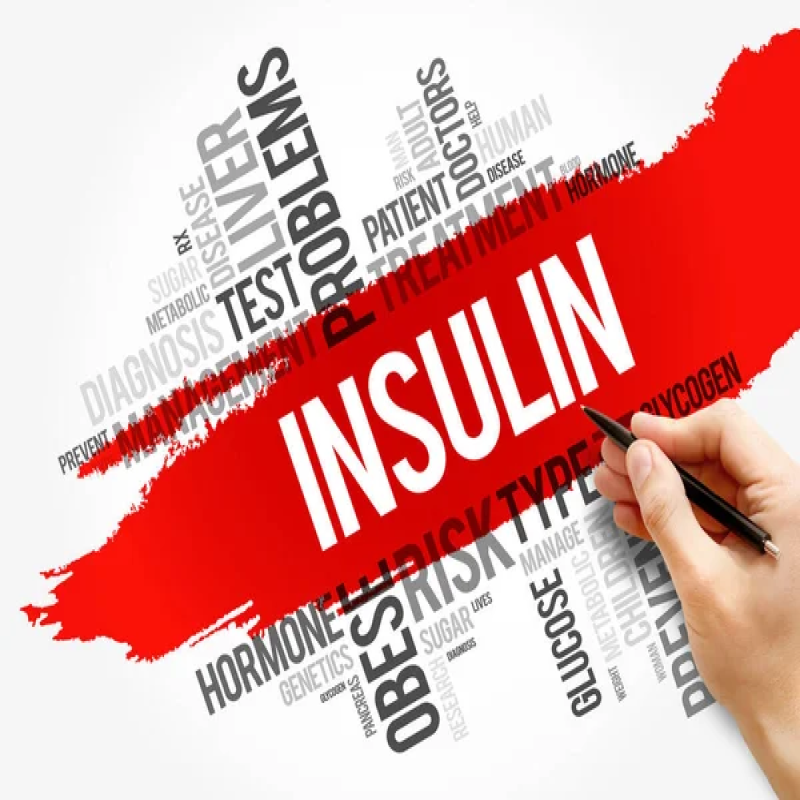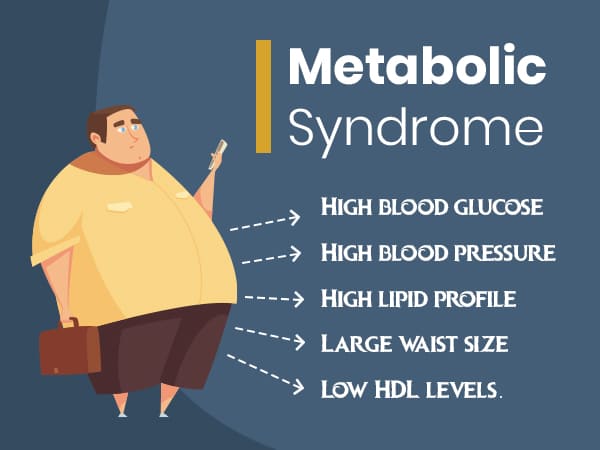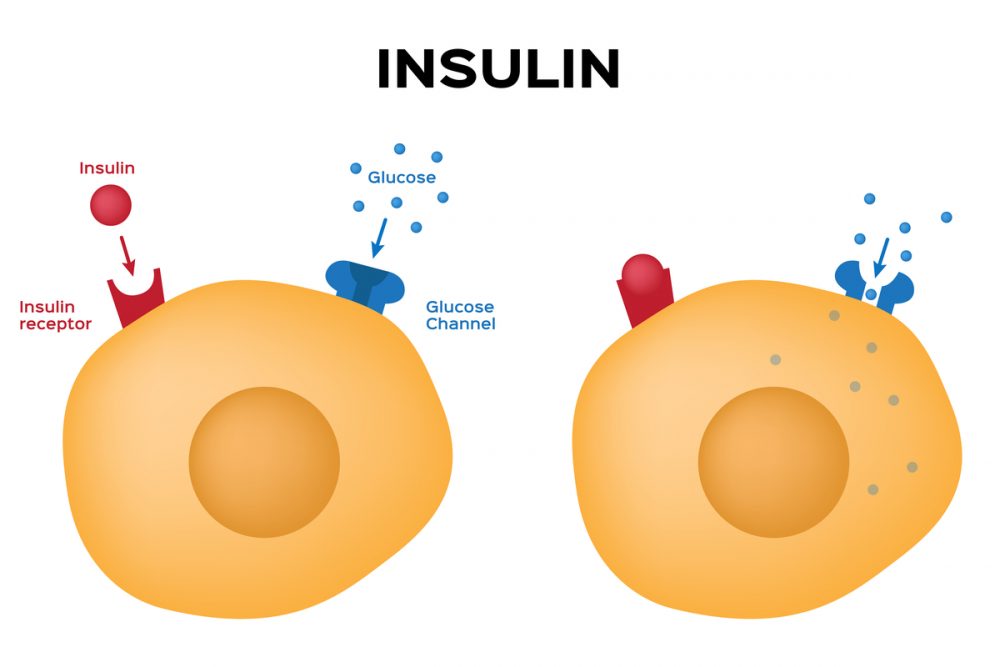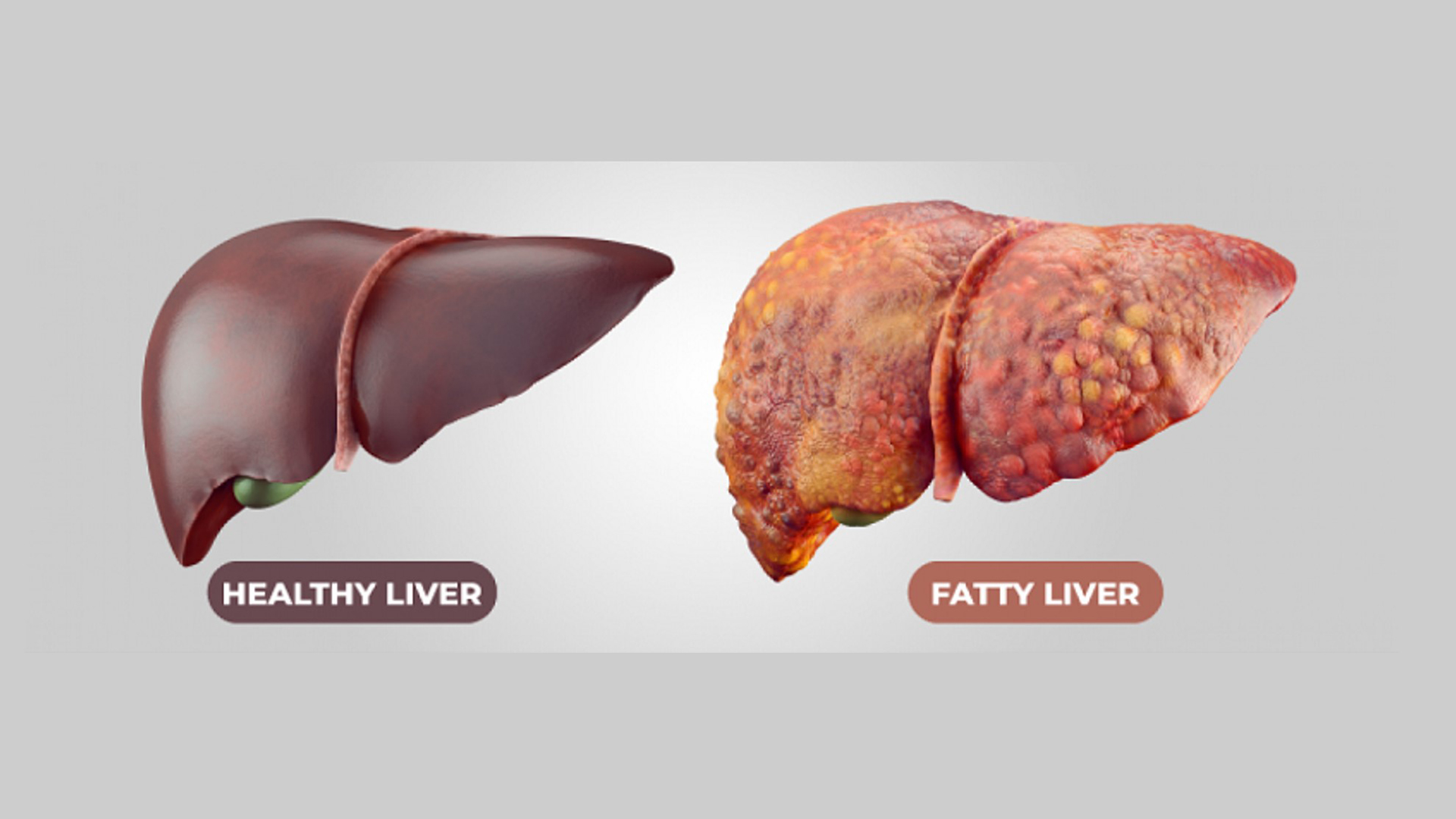
Metabolic syndrome is an umbrella term for a cluster of conditions that mostly occur together in an individual. These conditions include high blood pressure, high blood sugar, the presence of excess fat around the waist (visceral or hidden fat), and very high levels of cholesterol and triglycerides (fat found in the blood). An individual may be diagnosed as having metabolic syndrome if they suffer from three or more of the above-mentioned conditions.
You should get yourself checked for metabolic syndrome if you are experiencing any 3 of the points mentioned below:
- A waistline of 40 inches or more for men and 35 inches or more for women.
- A blood pressure of 130/85 millimeters Hg or higher. Hg stands for mercury.
- A triglyceride level above 150 milligrams per deciliter.
- A fasting blood glucose (sugar) level that is higher than 100 milligrams per deciliter.
- A High-Density Lipoprotein level (HDL) or good cholesterol level of less than 40 milligrams per deciliter for men and under 50 milligrams per deciliter for women.
Metabolic syndrome puts people at a higher risk of diabetes, heart disease, and stroke. It also leads to diseases that are caused by the buildup of excess fat in artery walls, especially liver diseases. Hyperglycemia, hyperinsulinemia, dyslipidaemia, and lipotoxicity are the warning signs of metabolic syndrome. All these conditions are tied together mainly by high insulin levels, which lead to insulin resistance. Obesity, a sedentary lifestyle, the wear and tear the body suffers as we age, and certain genetic factors might also contribute to metabolic problems, but insulin is the key factor here.

Low insulin levels are important for our overall health, which is why I have come up with the highly valuable and effective Winsulin Protocol. The Winsulin, or “Low-Insulin Protocol,” focuses mainly on eating a well-balanced diet and leading a more active lifestyle (rest is equally important). The diet also involves the use of certain herbs and supplements as required, depending on the person’s condition. In short, the Winsulin Protocol helps you regain supreme metabolic health without the use of medicines. Monitoring our glucose, cholesterol, and blood pressure levels at regular intervals or in cases of discomfort is equally important because insulin contributes to high glucose, high cholesterol, and high blood pressure levels as well. The exact treatment period and treatment plan for each individual depend on their condition at the time of reaching out for medical help.
But more on the Winsulin Protocol later; let’s first get to know how insulin actually impacts our bodies and lives.

The Many Roles of Insulin
The hormone insulin, produced by the pancreas, is made up of 51 amino acids and takes care of glucose homeostasis (balance), cell growth, and metabolism. It is also an adipogenic hormone, meaning a hormone that forms fat or fatty tissues. Thus, glucose (blood sugar) and fat are highly correlated, as the Randle cycle theory suggests.
Till now, research has mainly been focused on how an imbalance in insulin levels (basically, really high insulin levels) leads to diabetes, or at most, how it can lead to problems in the eyes and kidneys. However, recent research points to the fact that insulin affects several other important parts of the body, like the pancreas, brain, heart, kidney, bone, skin, and even hair follicles.
The role of insulin isn’t restricted to only major organs or surface-level organs; it impacts many processes at the molecular level as well.
How does the Winsulin Protocol help you get Low Insulin Levels?
In simple words, insulin is the fulcrum on which the body is supported. Since insulin plays a major role in regulating multiple physiological processes, maintaining low insulin levels is extremely important for our overall health. When the body can achieve low insulin levels, it sets off a chain reaction that heals all the organs and processes affected by high insulin levels. The Winsulin Protocol, helps you win at life.
With the help of the Winsulin Protocol, diabetes can be reversed. Fatty liver, fatty muscle, and adipose tissue can all go back to their lean and healthy forms. Plus, mitochondrial integrity is also restored.
Know more about the role of mitochondria in metabolic disorders!
Let's take a look at the various steps involved in the Winsulin Protocol treatment plan.

Step 1: Checking Patient’s History
A detailed history of the individual’s condition is requested so that a holistic treatment plan can be prepared. Previous reports are also taken into consideration. Some basic tests are also done to check the person’s current blood sugar, blood pressure, cholesterol levels, etc.
Step 2: Finding Out the Phenotype
The individual’s phenotype is given importance in this treatment plan, and the treatment is tailored according to it. Phenotype simply means the observable traits in a person, like their height, the color of their eyes, and their blood type. A person’s phenotype is dependent on their genomic makeup (genotype) as well as the environmental factors around them. In Ayurveda, an individual's body constitution, or Prakriti, is said to be divided into three broad phenotype categories, such as vata, pitta, and kapha, called doshas. If someone has a higher ratio of, say, vata in comparison to the other two, then they are said to be a predominantly vata person. The same goes for kapha and pitta. It has been established that if we adopt dosha-specific health practices, they can help us gain optimal physical, mental, and emotional health. We also take care of a person’s food preferences and sensitivities. Diet, exercise, rest, and mental health support can then be recommended accordingly.

Step 3: A Well-Balanced Diet
Diet is of extreme importance in bringing down insulin levels because, after all, it is food (mainly carbohydrates) that are converted into glucose and then energy. The Winsulin Protocol guides you on how to go about effectively managing your diet so that your insulin levels are down. We should take the utmost care not to have ultra-processed foods that are high in sugar and almost devoid of nutrients like fiber and proteins. They make the insulin hormone go haywire. Sugary drinks and alcohol should be taken very rarely, if at all. We need to make sure that we eat foods that are balanced in carbohydrates, healthy unsaturated fats (found in nuts and seeds), and proteins.
Click here to know about the link between ultra-processed food and diabetes.
However, we should avoid the high-carbohydrate, high-fat combination if we want to keep our insulin levels in check. Vegetables and fruits that are rich sources of vitamins, minerals, and antioxidants are also recommended. Lean proteins found in chicken, meat, etc., as well as fatty fish, are included in the diets of those who prefer non-vegetarian food. They prevent fat buildup around major organs. Keeping oneself hydrated is as important as drinking water, which is a key component of healing. The protocol can help individuals take care of their diet at home as well as when they plan to eat out.
Know about tips for eating out with diabetes!
The gut microbiome of each individual is different and determines our immune levels. Fibers feed the gut directly, and it’s important that the diet takes care of our gut health too. Such eating habits ensure good mitochondrial health as well as take care of the liver, heart, skeletal muscle, pancreas, adipose tissue, and nervous system. As per experts, it is best to consume 3 meals a day, preferably within a 9–10 hour window, preferably between 8 a.m. and 6 p.m., according to our circadian rhythm. One should take care not to consume very large meals. Intermittent fasting is as important as eating to remove damaged mitochondria and produce newer, healthier ones. All these together tend to keep insulin levels in check. In the Winsulin Protocol, we prepare customized diets for you that are sustainable, affordable, and efficient.
Step 4: Yoga, Exercises, and Meditation
Activity and rest are both equally important for our bodies. Physical activity makes our body more sensitive to insulin and thus helps control our blood sugar levels better. Moreover, it lowers our risk of heart disease and nerve damage.
Physical activity helps us maintain a healthy weight and gain or lose weight as needed. One can suddenly gain or lose a lot of weight in diabetes, especially. It helps us connect better socially and emotionally with other people when we workout at gyms together or take part in sporting events or physical activities like hiking, trekking, cycling, jogging, doing yoga, etc. It helps control blood pressure as well as lower the bad cholesterol and raise the good cholesterol in our system. What’s more, physical activity also helps us sleep better. It also helps our cardiovascular and cerebrovascular systems.
Yoga is our main focus in the Winsulin Protocol. We conduct about 60 live classes in a time span of 3 months. We also provide guidance for other kinds of exercises that people might want to pursue, both aerobic and anaerobic.

Some of the exercises that work best for bringing down insulin levels are resistance training and aerobic exercises, or what is called “cardio training,” like jumping rope, jumping jacks, squats, walking, jogging, swimming, etc. High-intensity Interval Training (HIIT) programs that mainly involve anaerobic exercises are also good for managing insulin levels. Examples include sprinting and weightlifting.
In the program, you will also be guided on how to manage your stress levels well so that you can sleep better and give your body adequate rest. As per many studies, poor sleep can lead to decreased insulin sensitivity. Have a look at this article that talks about the link between sleep and diabetes.
Step 5: Using Herbal Remedies
In the Protocol, you are also guided about how herbal remedies can help you get better. Let’s take a look at some of the herbal remedies.
- Fenugreek seeds (methi) are at the top of the list when it comes to herbal remedies. It helps brilliantly with insulin sensitivity. In many Indian homes, we use panchforan (a mixture of five spices that include fenugreek seeds; nigella, cumin, black mustard, and fennel seeds are the other four) for tempering (put tadka or chaunk) in all vegetable preparations. Putting these seeds in oil or ghee extracts the essential oils from inside these seeds and helps with digestion. Eating them whole, using them as a powder in the dough, drinking them with warm water, etc. are all beneficial. Methi ka parantha, methi ki missi roti, and methi saag-potato combo work well too.
- Next on the list is turmeric. The curcumin in it has powerful antioxidant and anti-inflammatory properties. It increases insulin sensitivity and reduces free fatty acids.
- Ginger is also highly beneficial in bringing down insulin levels. The component gingerol in it increases glucose uptake in the cells, thus reducing insulin resistance.
- Garlic may improve insulin secretion and increase insulin sensitivity.
- Rosemary, ginseng, sage, aloe vera, oregano, cinnamon, bitter gourd or karela, and gymnena (called “sugar destroyer” or gurmar as in gud or jaggery and mar as in kill).

Step 6: Supplements
Supplements are also given in certain cases if need be. Chromium, magnesium, berberine, and resveratrol are considered the best supplements to increase insulin sensitivity.
Conclusion
The Winsulin Protocol aims mainly at lowering insulin levels. After all, Winsulin stands for low insulin levels. Each individual’s physiological, mental, and emotional make-up is different, which is why we need treatment plans that are customized keeping each individual’s needs in mind. So the Winsulin Protocol takes care to prepare a holistic treatment plan suited to just your needs. Diet and exercise are given top priority, and mental health aid is also provided, all so you can regain supreme metabolic fitness.


.png)


